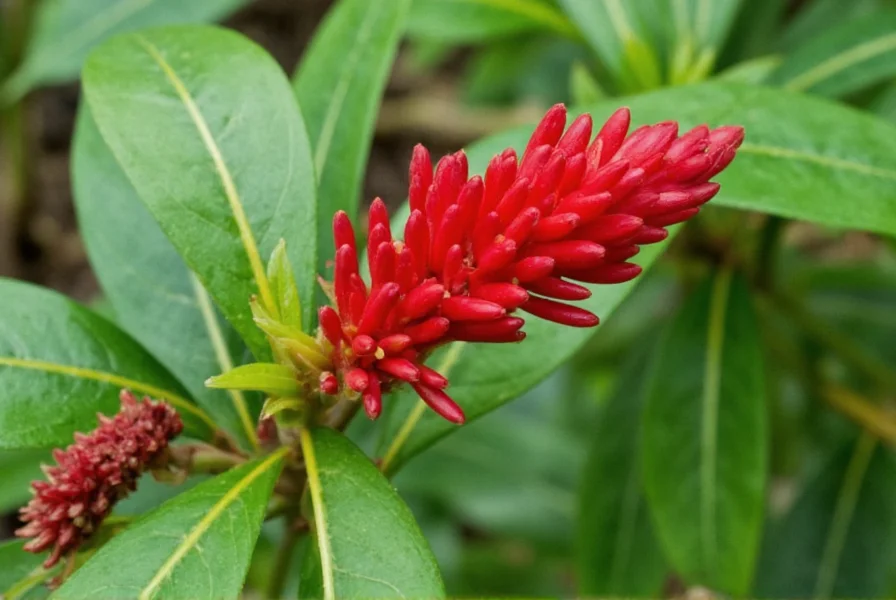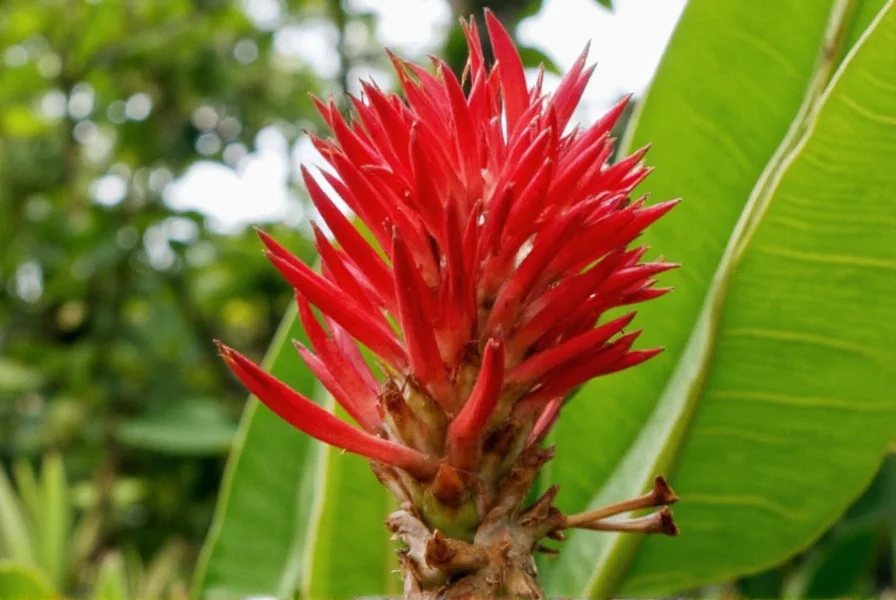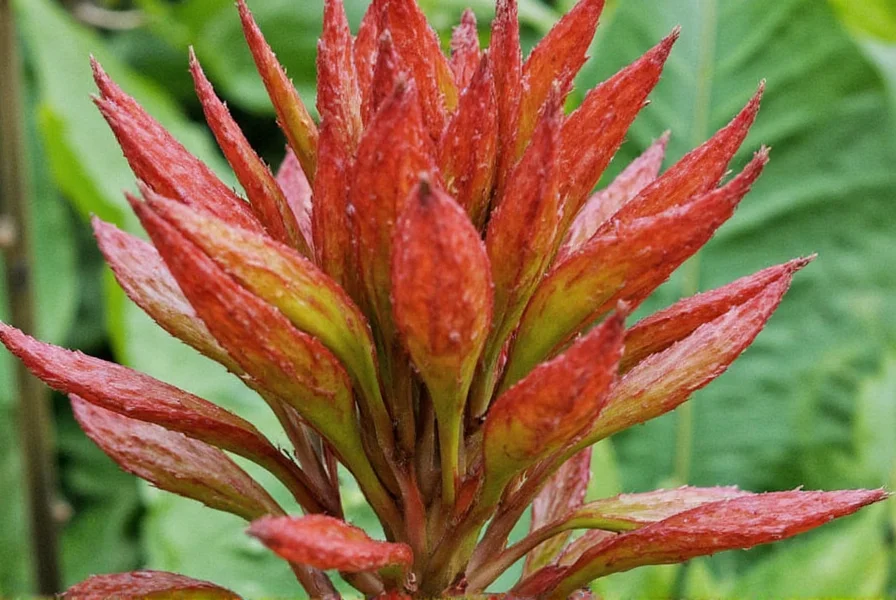Understanding Red Ginger: More Than Just a Colorful Name
When gardeners and horticulture enthusiasts search for "ginger red," they're typically seeking information about Alpinia purpurata, not the common culinary ginger. This distinction is crucial because while both belong to the Zingiberaceae family, they serve entirely different purposes in cultivation and use.
Botanical Characteristics of Red Ginger
Red ginger (Alpinia purpurata) features:
- Upright stems reaching 6-12 feet in height
- Large, glossy green leaves measuring 12-18 inches long
- Dense, cone-shaped inflorescences with overlapping red bracts
- Small white or yellow flowers that emerge from between the bracts
- Rhizomatous root system that spreads horizontally
The plant's most distinctive feature is its dramatic flower structure. What many mistake for the actual flowers are actually modified leaves called bracts, which protect the true flowers nestled within. These bracts maintain their vibrant color for weeks, making red ginger a popular choice for floral arrangements.
| Characteristic | Red Ginger (Alpinia purpurata) | Culinary Ginger (Zingiber officinale) |
|---|---|---|
| Primary Use | Ornamental | Culinary/Medicinal |
| Flower Color | Red, pink, or white | Yellow with purple accents |
| Rhizome Flavor | Mild, not typically used | Pungent, spicy |
| Height | 6-12 feet | 2-4 feet |
| Hardiness Zones | 9-12 | 8-12 |
Growing Conditions for Optimal Red Ginger Performance
Successful red ginger cultivation requires attention to specific environmental factors. This tropical plant flourishes in partial shade conditions, particularly in hotter climates where afternoon sun can scorch its leaves. The ideal temperature range spans 70-90°F (21-32°C), with protection needed when temperatures drop below 50°F (10°C).
Soil requirements include:
- Rich, organic matter content
- pH between 5.5-6.5 (slightly acidic)
- Excellent drainage to prevent rhizome rot
- Consistent moisture without waterlogging
For gardeners in cooler climates, red ginger can be grown in containers that can be moved indoors during winter months. When container growing, use a high-quality potting mix amended with perlite and monitor moisture levels carefully, as container soil dries out faster than garden soil.

Propagation and Maintenance Practices
Red ginger propagates most effectively through rhizome division. The best time for division is during spring when new growth begins to emerge. When dividing:
- Select healthy rhizomes with multiple growth nodes
- Use sterilized cutting tools to prevent disease transmission
- Allow cut surfaces to dry for 24 hours before planting
- Plant with growth nodes facing upward, covered with 1-2 inches of soil
Fertilization should follow a regular schedule during the growing season. A balanced 10-10-10 fertilizer applied monthly provides adequate nutrition, though some gardeners prefer specialized tropical plant formulas. Over-fertilization can lead to excessive foliage growth at the expense of flowering.
Common Challenges in Red Ginger Cultivation
While generally pest-resistant, red ginger can encounter several issues:
- Leaf spot diseases: Caused by fungal pathogens, appearing as brown spots with yellow halos. Manage by improving air circulation and avoiding overhead watering.
- Rhizome rot: Results from overly wet conditions. Prevention includes proper soil drainage and avoiding mulch piled against stems.
- Spider mites: Common in dry conditions, causing stippled foliage. Treat with insecticidal soap or neem oil.
- Yellowing leaves: Often indicates overwatering or nutrient deficiency, particularly magnesium.
One frequently asked question involves why red ginger might not be flowering. The most common causes include insufficient light (though it prefers partial shade, too much shade reduces blooming), inadequate nutrition, or the plant being too young. Mature red ginger plants typically begin flowering reliably after their second growing season.

Cultural Significance and Uses
Red ginger holds significant cultural importance throughout the Pacific Islands, particularly in Hawaii where it's known as 'awapuhi.' Traditional uses include:
- Floral arrangements for ceremonies and celebrations
- Lei making, with both flowers and leaves used
- Traditional medicine applications (though less common than with culinary ginger)
- Symbolic representation in various cultural practices
In contemporary settings, red ginger has become a staple in tropical landscape design, valued for its architectural form and dramatic color contrast. The long-lasting blooms make excellent cut flowers, often lasting two weeks or more in arrangements. Unlike culinary ginger, the rhizomes of red ginger aren't typically used for cooking due to their milder flavor profile.
Popular Varieties of Red Ginger
Gardeners have several distinctive varieties to choose from:
- 'Red Button': Features deep crimson bracts and compact growth habit
- 'White Ginger': Produces striking white bracts instead of red
- 'Pink Ginger': Offers soft pink inflorescences for a subtler look
- 'Christmas Ginger': Blooms reliably during winter months in tropical climates
When selecting a variety, consider your specific climate conditions and desired aesthetic. Some varieties perform better in certain microclimates than others, and bloom times can vary significantly between cultivars.
Seasonal Care Calendar for Red Ginger
Proper seasonal maintenance ensures optimal growth and flowering:
- Spring: Divide rhizomes, apply balanced fertilizer, increase watering as temperatures rise
- Summer: Maintain consistent moisture, monitor for pests, deadhead spent blooms
- Fall: Reduce fertilization, prepare container plants for indoor transition
- Winter: Protect from cold, reduce watering frequency, inspect for disease
Integrating Red Ginger into Landscape Design
Red ginger serves multiple design purposes in tropical and subtropical landscapes:
- Creates dramatic focal points when planted in groups of three or more
- Provides excellent backdrop for smaller flowering plants
- Works well along water features where its moisture needs are naturally met
- Functions as a privacy screen when planted in dense rows
- Complements other tropical plants like heliconias and bird of paradise
For best visual impact, position red ginger where its vibrant blooms will contrast with surrounding foliage. The plant's vertical growth habit makes it particularly effective when placed against darker green backgrounds or near water features where reflections enhance its visual appeal.
Frequently Asked Questions About Ginger Red
Is red ginger the same as regular ginger used in cooking?
No, red ginger (Alpinia purpurata) is primarily an ornamental plant with vibrant red bracts, while culinary ginger (Zingiber officinale) is grown for its edible rhizomes. Though both belong to the same plant family, they serve different purposes and have distinct characteristics.
Can I grow red ginger in a container?
Yes, red ginger grows well in containers, making it suitable for gardeners in cooler climates. Use a pot at least 18 inches in diameter with drainage holes, quality potting mix, and move indoors when temperatures drop below 50°F (10°C).
Why isn't my red ginger flowering?
Common reasons include insufficient light (needs partial shade), inadequate nutrition, the plant being too young (typically flowers reliably after second year), or improper watering. Ensure your plant receives balanced fertilizer during growing season and isn't planted in deep shade.
How do I propagate red ginger plants?
The most effective method is rhizome division in spring. Select healthy rhizomes with multiple growth nodes, use sterilized tools to divide, allow cut surfaces to dry for 24 hours, then plant with growth nodes facing upward covered with 1-2 inches of soil.
What are the ideal growing conditions for red ginger?
Red ginger thrives in partial shade, consistent moisture, and well-draining, slightly acidic soil (pH 5.5-6.5). It prefers temperatures between 70-90°F (21-32°C) and grows best in USDA zones 9-12. Protection from strong winds and afternoon sun in hotter climates improves performance.











 浙公网安备
33010002000092号
浙公网安备
33010002000092号 浙B2-20120091-4
浙B2-20120091-4